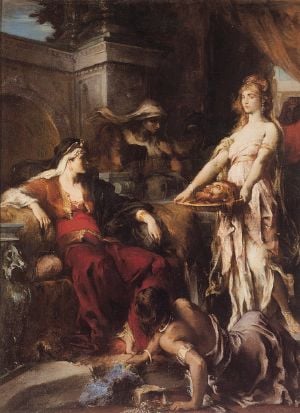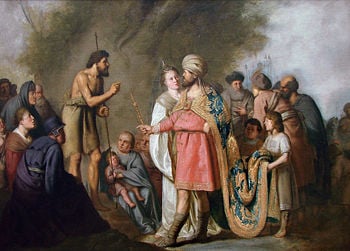Herodias
Herodias (c. 15 B.C.E.-after 39 C.E.) was a Jewish princess of the Herodian Dynasty and queen of Galilee, best known for her portrayal in the New Testament as the wife of Herod Antipas conspired in the death of John the Baptist.
The granddaughter of Herod the Great Herodias was first married to her uncle, one of the sons of Herod, with whom she lived in Rome. While on a visit to Rome her brother-in-law Antipas fell in love with her and proposed marriage, to which she assented. The couple then divorced their current spouses an married each other.
This union exacerbated tensions with Antipas' neighbor King Aretas of Nabatea, who was the father of his first wife and provoked criticism from John the Baptist on grounds that the union violated Jewish law. John was consequently imprisoned and later beheaded at the behest of Herodias' daughter.
Herodias later urged Antipas to appeal to Caligula for promotion to the title of king rather than tetrarch, move which brought his downfall when her nephew Agrippa accused Antipas of treason. Although offered clemency if she separated from her husband, she followed Antipas into exile at Lugdunum where she eventually died.
Life
Background
Herodias was the daughter of Aristobulus IV, one of the two sons of Herod the Great by the Hasmonean princess Mariamne I. She thus lived through the trauma of having both her mother and her two full brothers killed by her father, who became infamous for doing away with any member of his family he suspected of representing a threat to his throne. It also also gave her important credentials as a member of the Hasmonean line, seen by many Jews as more legitimate than Herod's own ancestry, since although he was a Jew by religion, he was an Idumean by ancestry. The Hasmoneans, on the other hand, had a long history of Jewish patriotism dating back to the Maccabean revolt.
Salome's mother, Berenice, was also of royal blood, being herself the daughter of Herod's sister Salome I, and of Costabarus, the governor of Idumea. Her siblings included Herod III, king of Chalkis; Herod Agrippa the future king of Judea; Aristobulus V; and Mariamne III who may have been the first wife of her uncle, Herod Archelaus, briefly the ethnarch of Judea.
Marriages
Around the year 1 or 2 C.E., Herodias married her uncle, Herod II, also called Herod Boethus, a son of Herod the Great and Mariamne II, the daughter of the high priest Simon Boethus. The Gospel of Mark calls Herod II "Philip," but this is probably an error, Philip being another son of Herod who was tetrarch of the territories east of the Sea of Galilee. Although seen for a while as the successor of Herod the Great, Herod II fell from grace after his father came to suspect his mother of treason and was not included in Herod's will in the plan to divide his kingdom among his other sons.
He and Herodias nevertheless lived as in relative luxury somewhere on the Mediterranean coast of the Levant and enjoyed considerable influence in Rome. Herodias had a daughter, born around 14 C.E., whom she named Salome after her maternal grandmother.
Around 23, Herodias divorced Herod II and married another uncle, Herod Antipas, tetrarch of Galilee and Peraea. It is traditionally believed that Herod Antipas and Herodias truly loved each other, but political considerations were no doubt important considerations. Herodias' Hasmonean descent was vital asset for Antipas' ambitions, which were certainly to rise to the position of king and possibly to unite his lands with those of Judea, which were now governed directly by the Romans after his brother Archeaelus proved to be incompetent. For Herodias, her marriage with Antipas improved her social status significantly and she was close to being a queen, a position she might have hope for ever since her betrothal to her first husband when he was still the heir-apparent of Herod the Great.
For Hellenistic Jews the marriage may not have been extremely controversial. Indeed, there is reason to believe that some had great hopes in the restoration of a Jewish kingdom under Antipas and Herodias. The so-called Herodians referred to in the New Testament may have been such as faction. However the couple's union was not well received by at least some of Antipas' subjects, as it offended the religious sensibilities of many Jews. Indeed, Antipas' and Herodias' union was considered a violation of Jewish marriage law, which commands: "if a man shall take his brother's wife, it is an unclean thing; he hath uncovered his brother's nakedness." (Leviticus 20:21). Although this was not a case of half-brothers, Antipas was openly criticized by John the Baptist who declared: "It is not lawful for you to have your brother's wife." (Mark 6:18) The criticism stung the couple enough that Antipas had the Baptist arrested.
In the Gospels of Mark and Matthew, Herodias plays a major role in John the Baptist's execution, using her daughter's dance before Antipas and his party guests to ask for the head of the Baptist as a reward. Mark 6 contends that Antipas did not want to put John the Baptist to death, both fearing his popularity and respecting his holiness. Matthew's account follows Mark in placing the blame squarely on Herodias:

On Herod (Antipas)' birthday the daughter of Herodias danced for them and pleased Herod so much that he promised with an oath to give her whatever she asked. Prompted by her mother, she said, "Give me here on a platter the head of John the Baptist." The king was distressed, but because of his oaths and his dinner guests, he ordered that her request be granted and had John beheaded in the prison. His head was brought in on a platter and given to the girl, who carried it to her mother. (Matt. 14:6-11)
In 37 C.E., Herodias' brother Herod Agrippa was made king over the territories of the eastern territories Batanaea and Trachonitis. Previously, Herodias had intervened with the emperor Tiberius on Agrippa's behalf and secured financial assistance for him from Antipas. However, he later quarreled with Antipas and parted from Herodias or less then friendly terms. Herodias now prodded Antipas to sail for Rome and ask the title of king from the the new emperor, Caligula. They embarked for Italy in late 39. However, they were outsmarted by Agrippa, who had sent letters to Caligula denouncing Antipas' alliance with Parthia and alleging that he was stockpiles weapons for a rebellion. Caligula deposed Antipas and sentenced him to exile in what is now Lyon (Gaul), offered Herodias the possibility to return in Judea and live at the court of her brother. She refused the offer and accompanied her husband in his banishment. They probably died in their exile shortly afterward.
Legacy
Herodias' bold move of divorcing her first husband in favor of Antipas has been the subject of much discussion. Traditionally, she is portrayed as a latter-day Jezebel, using her influence in a bloodthirsty quest for revenge against John the Baptist for daring to impugn the basis of her marriage in moral and religious terms. Herodias and her daughter would become famous subjects in art for their role, which provides dramatic opportunities to portray Salome's famous "dance of the seven veils" and Herodias receiving the severed head of the Baptist on a plate, or presenting the head to Antipas. Feminist scholarship questions this portrayal, seeing it as far more likely that, as the ancient Jewish historical Josephus suggests, the Baptist was simply put to death by Antipas for sedition without mention of Herodias' role. A critique of John the Baptist offered by the Reverend Sun Myung Moon suggests that John the Baptist sinned more greatly even than Herodias for using his ministry to attacking the Antipas and Herodias rather than concentrating on supporting the Messianic role of Jesus.
In medieval Europe a widespread belief held Herodias to be the supernatural leader of a supposed cult of witches, synonymous with Diana, Holda and Abundia. She has also been portrayed in numerous works of fiction, drama, and film:
- Hérodiade, opera by Jules Massenet.
- Hérodias, story by Gustave Flaubert, one of the Three Tales (Trois contes), published in 1877.
- Salomé, play by Oscar Wilde, French (1894), translated into English by Lord Alfred Douglas, 1895.
- Salome, opera by Richard Strauss, based on a German translation of the play by Oscar Wilde.
ReferencesISBN links support NWE through referral fees
- Gillman, Florence Morgan. Herodias: At Home in the Fox's Den. Interfaces. Collegeville, Minn.: Liturgical Press, 2003.
- Meier, John P. A Marginal Jew: Rethinking the Historical Jesus, Volume Two: Mentor, Message and Miracles. Anchor Bible Reference Library, New York: Doubleday, 1994.
- Theissen, Gerd. The Shadow of the Galilean: The Quest of the Historical Jesus in Narrative Form. Philadelphia: Fortress, 1987.
Credits
New World Encyclopedia writers and editors rewrote and completed the Wikipedia article in accordance with New World Encyclopedia standards. This article abides by terms of the Creative Commons CC-by-sa 3.0 License (CC-by-sa), which may be used and disseminated with proper attribution. Credit is due under the terms of this license that can reference both the New World Encyclopedia contributors and the selfless volunteer contributors of the Wikimedia Foundation. To cite this article click here for a list of acceptable citing formats.The history of earlier contributions by wikipedians is accessible to researchers here:
The history of this article since it was imported to New World Encyclopedia:
Note: Some restrictions may apply to use of individual images which are separately licensed.

